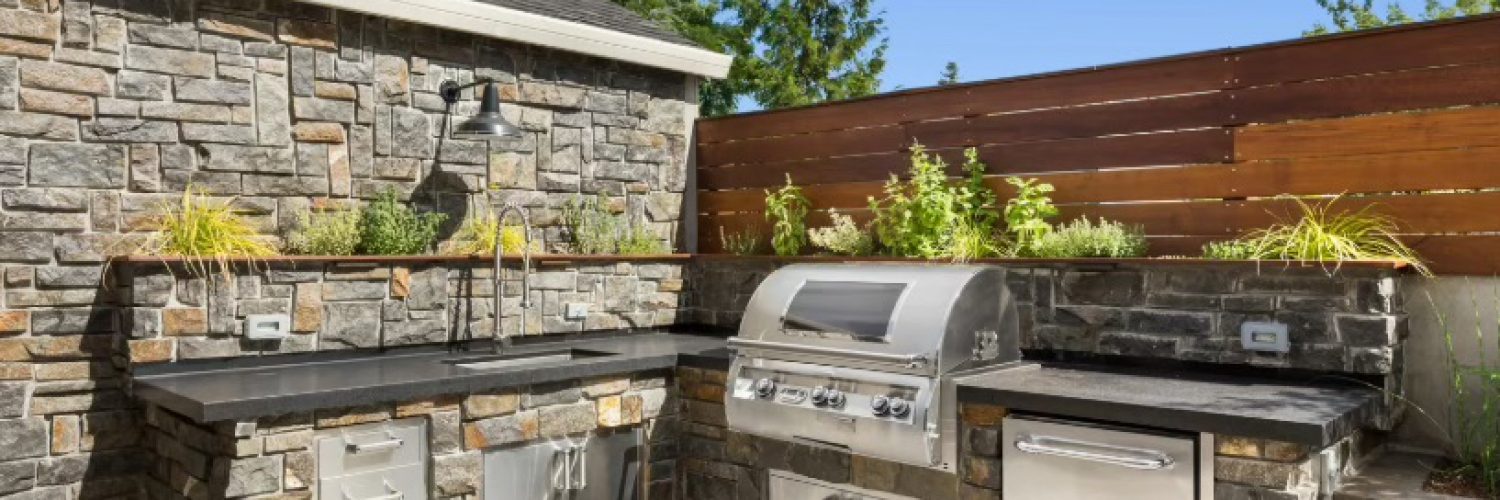Are you dreaming of transforming your backyard into an outdoor entertainment paradise? An outdoor kitchen can be the centerpiece of your outdoor living space, providing functionality, beauty, and value to your home.
Whether you’re planning a simple setup with a built-in grill or an elaborate outdoor culinary haven, proper planning is essential for success. This comprehensive guide will walk you through every step of creating your perfect outdoor kitchen, from initial design considerations to final installation details.
Understanding Your Outdoor Kitchen Needs
Before diving into design specifics, it’s important to assess your unique needs and expectations. The most successful outdoor kitchen projects begin with thoughtful planning that considers how you’ll actually use the space.
Assessing Your Space and Requirements
Start by evaluating your available outdoor area and how you plan to use your kitchen. Will you be hosting large gatherings regularly, or is this primarily for intimate family dinners? Do you need a fully functional cooking space, or is a simple grill station sufficient? Consider your cooking style and preferences. Are you an avid griller, or do you need versatility for various cooking methods?
Your climate plays a crucial role in determining the design and materials for your outdoor kitchen. In Charlotte and surrounding areas like Waxhaw, the relatively mild climate allows for extended outdoor cooking seasons, but you’ll still want to consider seasonal adaptations for comfort during summer heat and winter chill.
Setting a Realistic Budget
Outdoor kitchen projects can range from a few thousand dollars for basic setups to $50,000+ for luxury installations. According to recent industry data from 2024, the average cost of a mid-range outdoor kitchen falls between $12,000 and $20,000. Breaking down your budget into categories helps ensure you allocate funds appropriately:
- Appliances: 30-35% of total budget
- Countertops and cabinetry: 20-25%
- Utility connections: 15-20%
- Labor and installation: 20-30%
- Additional features (lighting, seating, etc.): 10-15%
Remember to include a 10-15% contingency fund for unexpected expenses that inevitably arise during construction projects. Many homeowners find that investing in quality hardscaping provides better long-term value than cutting corners on materials or craftsmanship.
Selecting the Perfect Location
The location of your outdoor kitchen significantly impacts both functionality and enjoyment. Several factors should influence this critical decision.
Climate and Weather Considerations
Position your outdoor kitchen to take advantage of natural shade during peak cooking hours while ensuring adequate ventilation for smoke and cooking odors. In the Charlotte area, consider prevailing wind patterns to prevent smoke from blowing into your home or seating areas.
Protection from the elements is essential for comfort and longevity. Options include:
- Pergolas or partial roofs for shade and light rain protection
- Full roofing structures for all-weather use
- Retractable awnings for flexibility
- Strategic placement near existing structures
According to a 2024 survey by the Outdoor Living Association, outdoor kitchens with some form of overhead protection see 60% more use throughout the year than completely exposed installations.
Proximity to Indoor Kitchen
The relationship between your indoor and outdoor kitchens affects convenience and workflow. Industry experts recommend positioning your outdoor kitchen within reasonable proximity to your indoor kitchen, ideally 15 to 20 feet, to facilitate easy transport of food and supplies.
Consider the path between spaces: Is it direct and obstacle-free? Will you need to navigate stairs? Is there a door wide enough for easy passage? Some homeowners opt to transform their yard with professional landscape design that creates a seamless flow between indoor and outdoor cooking areas.
Utility connections also influence location decisions. Proximity to existing gas, water, and electrical lines can significantly reduce installation costs. A professional landscape contractor in Charlotte can help assess the most cost-effective placement based on your property’s existing infrastructure.
Designing Your Outdoor Kitchen Layout
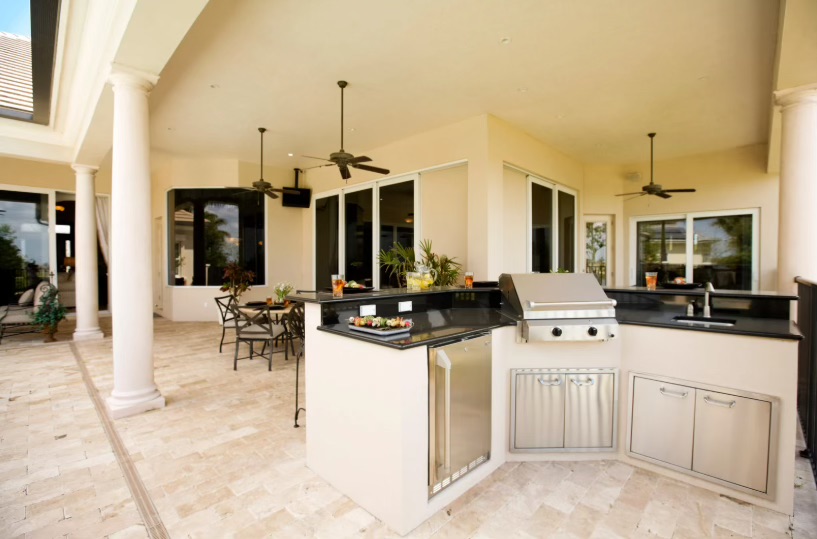
The layout of your outdoor kitchen should balance functionality, space efficiency, and aesthetic appeal. Thoughtful design ensures your outdoor cooking experience is enjoyable rather than frustrating.
Popular Configuration Options
Several standard layouts have proven effective for outdoor kitchens:
- Straight-line (I-shape): The simplest and most economical design, ideal for smaller spaces or placement against a wall.
- L-shape: Provides more counter space and creates a partial boundary for the cooking area.
- U-shape: Maximizes efficiency with three walls of workspace, perfect for larger installations.
- Island: Creates a central cooking hub that allows for 360-degree access and social interaction.
Your choice should reflect both your available space and how you plan to use the kitchen. For entertainment-focused spaces, island or L-shaped designs often work best as they facilitate interaction between the cook and guests.
Space Planning and Traffic Flow
Effective outdoor kitchens require thoughtful traffic flow planning. Allow at least 48 inches of clearance in work areas and pathways. For dining areas, plan 24 inches of table edge per seated guest and ensure at least 36 inches behind chairs for comfortable movement.
The most successful outdoor kitchens aren’t necessarily the largest or most expensive. They’re the ones designed with careful attention to workflow, traffic patterns, and the specific needs of the homeowners.
Consider sight lines from your cooking area. Position your grill or cooking station to maintain visual connection with seating areas and views. This allows the cook to remain part of the social experience rather than feeling isolated. Many Charlotte landscape design experts specialize in creating outdoor kitchens that balance functionality with social engagement.
Essential Outdoor Kitchen Zones
Like indoor kitchens, outdoor cooking spaces function best when organized into distinct zones that support the cooking process from start to finish.
Cooking Zone: Appliance Selection and Placement
The cooking zone forms the heart of your outdoor kitchen. When selecting appliances, consider both your cooking style and budget:
Built-in grills remain the most popular centerpiece, with options including gas, charcoal, pellet, and hybrid models. High-quality gas grills start around $1,500, while premium models from brands like Weber, Lynx, or Big Green Egg can exceed $5,000. Beyond grills, consider specialty cooking appliances like:
- Pizza ovens
- Smokers
- Side burners
- Power burners for large pots
- Flat-top griddles
Placement should prioritize safety and functionality. Maintain clearance from combustible materials according to manufacturer specifications, typically 12-24 inches. Position cooking appliances away from high-traffic areas to prevent accidents and consider wind direction to manage smoke.
Prep and Storage Zones
Efficient outdoor cooking requires adequate preparation space and storage. Plan for at least 24 inches of countertop on each side of your grill or cooking appliance. For comprehensive outdoor kitchens, aim for 36-48 inches of total prep space.
Storage solutions should be specifically designed for outdoor environments. Weather-resistant cabinetry in stainless steel, marine-grade polymer, or treated wood provides protection for utensils, tools, and supplies. Include a mix of drawers, cabinets, and specialized storage like:
- Pull-out trash and recycling bins
- Propane tank storage
- Tool drawers with dividers
- Dry storage for paper goods
Refrigeration options range from simple drop-in coolers to sophisticated outdoor-rated refrigerators, wine chillers, and ice makers. These convenience features eliminate trips to the indoor kitchen and enhance the self-sufficiency of your outdoor cooking space.
Serving and Dining Areas
The transition from cooking to dining should feel natural and convenient. Bar-height counters with seating create casual dining spaces that keep guests close to the action. For larger gatherings, dedicated dining tables positioned within view of the cooking area maintain the social atmosphere.
Consider incorporating fire pit features adjacent to dining areas to extend usability into cooler evenings. According to 2024 outdoor living trends, integrated fire features rank among the top three most-requested elements in outdoor kitchen projects.
Entertainment Features
Modern outdoor kitchens often extend beyond cooking to become complete entertainment destinations. Popular additions include:
- Weather-resistant audio systems
- Outdoor-rated televisions
- Lighting systems with ambiance settings
- Outdoor fireplaces for gathering spaces
These elements transform your outdoor kitchen from a purely functional space into an outdoor living room that encourages longer, more enjoyable gatherings. When planning entertainment features, ensure adequate electrical supply and protection from the elements.
Material Selection Guide
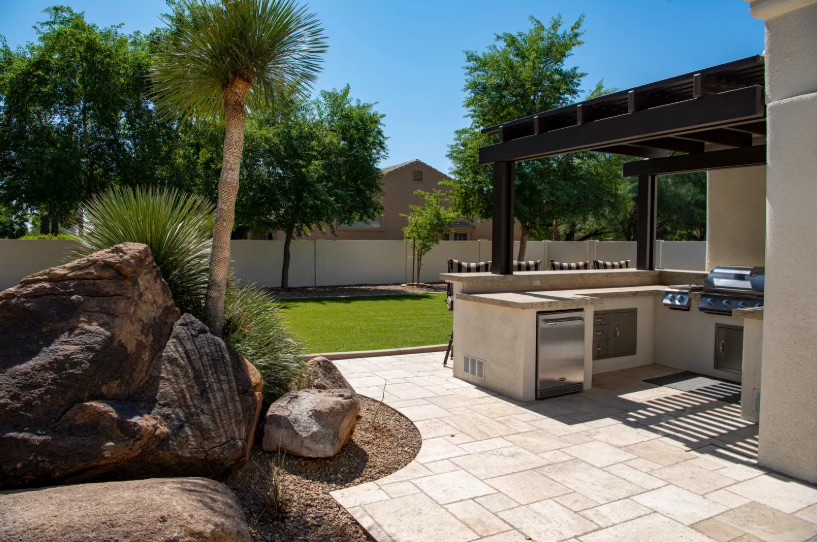
The materials you choose for your outdoor kitchen must withstand exposure to weather, temperature fluctuations, cooking heat, and regular use. Durability should be your primary consideration, followed by maintenance requirements and aesthetic appeal.
Countertop Options and Comparisons
Countertop selection balances durability, maintenance, and style:
- Granite: Natural stone remains popular for its heat resistance and durability. Requires annual sealing but withstands the elements beautifully. Cost: $60-100 per square foot installed.
- Concrete: Offers unlimited customization in color and finish. Requires sealing but provides excellent durability. Cost: $65-135 per square foot for custom work.
- Porcelain: Increasingly popular for its low maintenance and high durability. Resistant to staining, scratching, and UV fading. Cost: $60-100 per square foot installed.
- Quartzite: Natural stone with excellent durability and heat resistance. More resistant to etching than granite. Cost: $70-120 per square foot installed.
For Charlotte’s climate, which experiences both hot summers and occasional freezing temperatures, materials with good freeze-thaw resistance like granite and porcelain typically perform best long-term.
Weather-Resistant Cabinet Materials
Cabinet materials must withstand humidity, temperature changes, and potential exposure to rain:
- Stainless steel: The gold standard for outdoor durability, though more expensive. 316 marine-grade stainless offers superior corrosion resistance. Cost: $800-1,200 per linear foot.
- Marine-grade polymer: Completely waterproof and maintenance-free. Won’t rot, warp, or fade. Cost: $600-900 per linear foot.
- Masonry: Built-in concrete or stone cabinets offer permanence and weather resistance. Cost varies widely based on materials and complexity.
In high-humidity environments like Charlotte, sealed cabinets with proper ventilation prevent moisture accumulation and extend cabinet life.
Flooring Considerations
Your outdoor kitchen flooring should be slip-resistant, durable, and able to withstand spills and stains. Popular options include:
- Concrete pavers: Durable and available in numerous styles. Can be sealed for stain resistance. Cost: $15-30 per square foot installed.
- Natural stone: Materials like bluestone, travertine, or slate offer beauty and longevity. Cost: $25-50 per square foot installed.
- Porcelain tile: Extremely durable and low-maintenance with excellent stain resistance. Cost: $20-40 per square foot installed.
Working with expert hardscaping professionals ensures proper installation with appropriate drainage slopes and foundation preparation to prevent settling and cracking over time.
Utility Planning
Proper utility planning is critical for functionality and safety in outdoor kitchens. This often-overlooked aspect requires careful consideration and professional installation.
Electrical Requirements
Most outdoor kitchens require dedicated electrical circuits to power appliances, lighting, and entertainment features. Plan for:
- GFCI-protected outlets at convenient locations
- Dedicated circuits for major appliances
- Weather-resistant covers and conduits
- Proper grounding for safety
According to the National Electric Code, outdoor kitchens require specific protection measures including in-use weatherproof covers and proper circuit protection. Professional installation is strongly recommended to ensure code compliance and safety.
Plumbing Considerations
If your design includes a sink or ice maker, you’ll need water supply and drainage. Consider:
- Freeze protection for water lines in colder months
- Proper drainage that meets local codes
- Shut-off valves for winterization
- Hot water access if desired
In Charlotte’s climate, which can experience freezing temperatures, proper winterization is essential to prevent pipe damage. Charlotte landscaping services with outdoor kitchen expertise can design systems with appropriate freeze protection measures.
Gas Line Installation
For gas grills and other cooking appliances, professional gas line installation is essential for safety. Natural gas installations require a dedicated line from your home’s gas system, while propane setups need proper tank storage and connection.
Gas lines must be properly sized based on the BTU requirements of all appliances and the distance from the source. This is absolutely not a DIY project. Professional installation by licensed contractors is required by code and critical for safety.
Permits and Building Codes
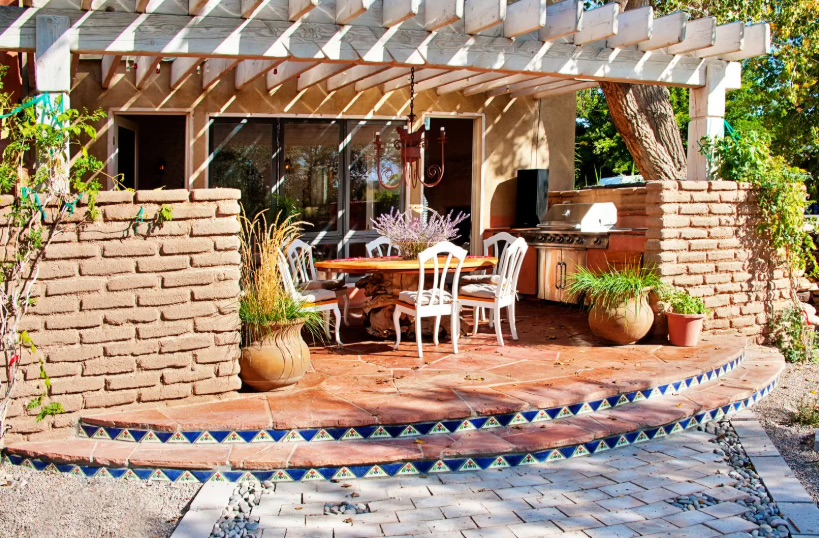
Navigating permits and building codes is a necessary step in outdoor kitchen construction. Requirements vary by location, but most substantial outdoor kitchen projects require some form of permitting.
Common Regulations for Outdoor Kitchens
Typical code requirements address:
- Setbacks from property lines
- Gas line installation standards
- Electrical code compliance
- Ventilation requirements for covered areas
- Fire safety clearances
- Structural requirements for supporting heavy countertops and appliances
In Charlotte and surrounding areas, outdoor kitchens that include gas lines, electrical work, or structural elements typically require permits. Some neighborhoods with HOAs may have additional restrictions or design review requirements.
Working with Contractors and Inspectors
Professional landscape architects in Charlotte can navigate the permitting process on your behalf, ensuring all requirements are met. When selecting contractors, verify they:
- Are properly licensed and insured
- Have specific experience with outdoor kitchens
- Can provide references for similar projects
- Understand local code requirements
- Will obtain all necessary permits and inspections
The permitting process typically adds 2-4 weeks to your project timeline but provides assurance that your outdoor kitchen meets safety standards and won’t face compliance issues in the future.
Step-by-Step Installation Process
Understanding the installation process helps set realistic expectations for your project timeline and prepares you for the construction phase.
DIY vs. Professional Installation
While simple outdoor kitchen elements might be suitable for DIY enthusiasts, most comprehensive outdoor kitchens benefit from professional installation. Components requiring professional expertise include:
- Gas line installation (always professional)
- Electrical work (always professional)
- Plumbing connections
- Structural elements supporting heavy countertops
- Custom masonry work
For those with appropriate skills, certain aspects like simple paver installation or assembly of modular components might be DIY-friendly. However, a professional outdoor kitchen contractor brings expertise that ensures proper installation and long-term durability.
Timeline and Project Management
A typical outdoor kitchen installation follows this sequence:
- Design and planning: 2-4 weeks
- Permitting: 2-4 weeks
- Site preparation and foundation: 1-2 weeks
- Utility rough-ins (gas, electric, water): 1 week
- Structure and cabinet installation: 1-2 weeks
- Countertop template and fabrication: 2 weeks
- Countertop installation: 1 day
- Appliance installation: 1-2 days
- Finishing details and cleanup: 2-3 days
From start to finish, expect a comprehensive outdoor kitchen project to take 8-12 weeks, with weather conditions potentially extending this timeline. Working with established landscape design experts helps ensure efficient project management and coordination between various trades.
Seasonal Maintenance Guide
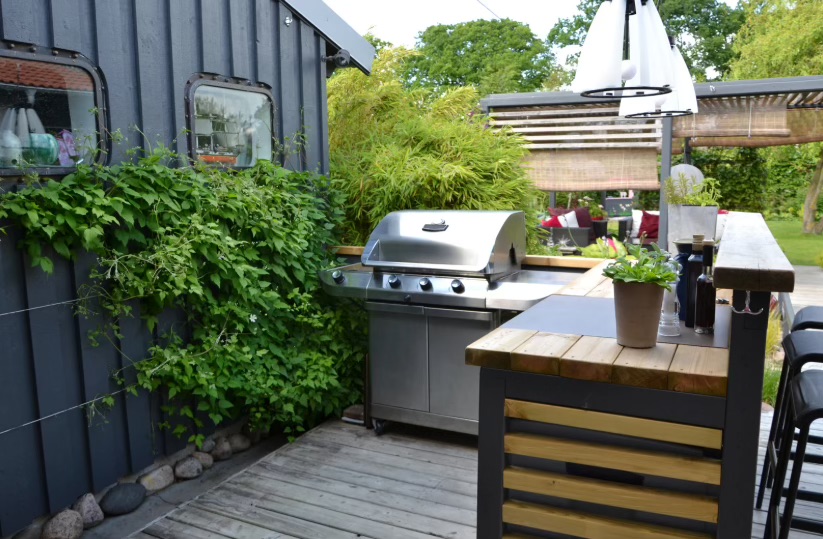
Proper maintenance extends the life of your outdoor kitchen and ensures it remains beautiful and functional for years to come.
Winterizing Your Outdoor Kitchen
In Charlotte’s climate, winter preparation is essential even though freezing temperatures are less severe than in northern regions. Before winter:
- Shut off and drain water lines
- Clean and cover grills and appliances
- Empty and clean refrigerators, leaving doors slightly open
- Cover countertops if not under a roof structure
- Store removable accessories indoors
- Clean and seal natural stone surfaces if recommended
For gas lines, consult with a professional about whether winterization is necessary based on your specific installation and local climate conditions.
Annual Maintenance Checklist
Regular maintenance throughout the year keeps your outdoor kitchen in top condition:
- Spring: Deep clean all surfaces, inspect for winter damage, check gas connections, test appliances
- Summer: Regular cleaning of cooking surfaces, touch-up sealing as needed
- Fall: Prepare for reduced use, clean gutters above kitchen areas, inspect for repairs needed before winter
- Ongoing: Clean countertops after each use, cover appliances when not in use
Establishing a maintenance routine preserves both functionality and appearance, protecting your investment for the long term.
Your Outdoor Culinary Journey Begins Today
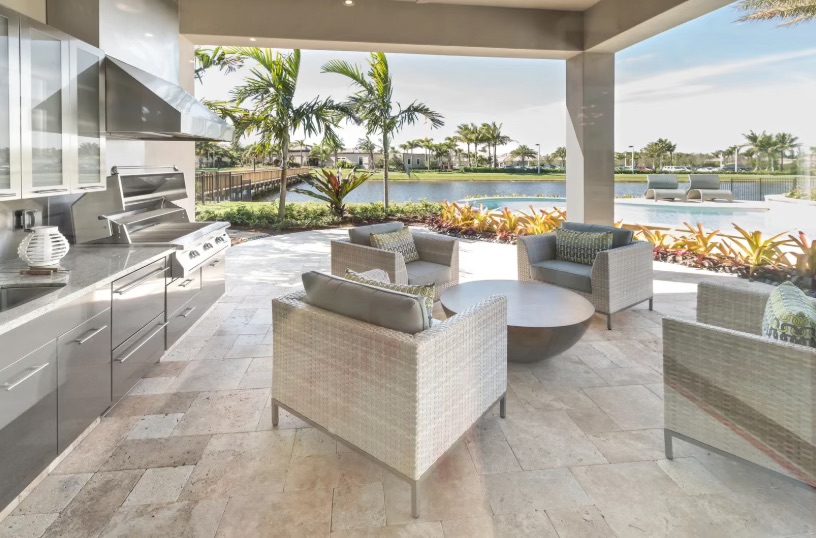
Creating your dream outdoor kitchen is an exciting journey that enhances your home’s value and your quality of life. With careful planning, quality materials, and professional installation, your outdoor cooking space will provide years of enjoyment and memorable gatherings.
JH Landscapes specializes in creating custom outdoor kitchens that perfectly balance functionality, durability, and beauty. Our experienced team guides you through every step of the process, from initial design concepts to final installation details. We handle all permitting, coordinate with specialty contractors, and ensure your project meets the highest standards of craftsmanship.
Ready to transform your backyard into an outdoor culinary paradise? Contact JH Landscapes today at (704) 999-0976 for a consultation and discover how we can bring your outdoor kitchen vision to life. Don’t wait another season to enjoy the benefits of outdoor living and entertaining. Your perfect outdoor kitchen is closer than you think.
Frequently Asked Questions
What is the average cost of building an outdoor kitchen in Charlotte?
In the Charlotte area, outdoor kitchen costs typically range from $10,000 for basic installations to $50,000+ for luxury outdoor kitchens with premium appliances and materials. The average mid-range project falls between $15,000-$25,000. Factors affecting cost include size, appliance quality, material choices, and utility requirements.
According to 2024 data, homeowners typically recoup 65-75% of their outdoor kitchen investment in home value, making it both a lifestyle enhancement and a financial investment.
How long does it take to build an outdoor kitchen from start to finish?
A complete outdoor kitchen project typically takes 8-12 weeks from initial design to final installation. This timeline includes 2-4 weeks for design and planning, 2-4 weeks for permitting, and 4-6 weeks for construction. Custom elements like specialty countertops may extend this timeline. Weather conditions can also impact the schedule, particularly for projects scheduled during Charlotte’s rainy seasons. Working with experienced professionals helps ensure efficient project management and timely completion.
What are the most durable countertop materials for outdoor kitchens?
The most durable outdoor countertop materials include granite, porcelain, and concrete. Granite offers excellent heat resistance and durability with proper sealing. Porcelain provides superior stain and UV resistance with minimal maintenance. Concrete delivers customizable aesthetics and good durability when properly sealed.
For Charlotte’s climate, which experiences both hot summers and occasional freezing temperatures, materials with good freeze-thaw resistance like granite and porcelain typically perform best long-term.
Do I need permits to build an outdoor kitchen in Charlotte?
Yes, most substantial outdoor kitchen projects in Charlotte require permits, particularly those involving gas lines, electrical work, or structural elements. Requirements vary based on project scope and location. Some neighborhoods with HOAs may have additional restrictions or design review requirements. Working with professional landscape contractors familiar with local regulations ensures proper permitting and code compliance. The permitting process typically adds 2-4 weeks to your project timeline but provides important safety assurances.
How can I extend the seasonal use of my outdoor kitchen in varying weather?
To maximize year-round enjoyment of your outdoor kitchen in Charlotte’s climate, consider incorporating: overhead structures like pergolas or roofs for shade and rain protection; retractable screens or glass enclosures for wind protection; integrated heating elements such as overhead heaters or built-in fireplaces; proper lighting for evening use; and fans for summer cooling. Strategic positioning relative to prevailing winds and natural shade also extends usability. With thoughtful design, many Charlotte homeowners enjoy their outdoor kitchens 9-10 months of the year.
About JH Landscapes
JH Landscapes is a premier landscape design and installation company serving Charlotte, NC and surrounding communities. With over 15 years of experience creating exceptional outdoor living spaces, our team specializes in custom outdoor kitchens, hardscaping, and comprehensive landscape transformations. We pride ourselves on quality craftsmanship, innovative designs, and attentive customer service. From initial concept to final installation, JH Landscapes delivers outdoor environments that enhance both your property value and quality of life.

